Change Management Report: Malaysian Airline System Bhd Analysis
VerifiedAdded on 2019/12/03
|25
|9167
|232
Report
AI Summary
This report delves into the application of change management principles within Malaysian Airline System Bhd, examining the company's challenges and strategic responses. It provides an overview of the company, highlighting its operational environment and competitive landscape. The main body of the report evaluates the issues influencing Malaysian Airlines' business restructuring and privatization, including financial losses and loss of goodwill. It explores the application of the Action Research Cycle and the Hofstede Cultural Framework to assess and manage the changes. The report concludes with recommendations for the company's restructuring and privatization efforts, offering insights into how Malaysian Airlines can navigate its current challenges and improve its market position. The analysis uses various sources of information to support the findings and recommendations.
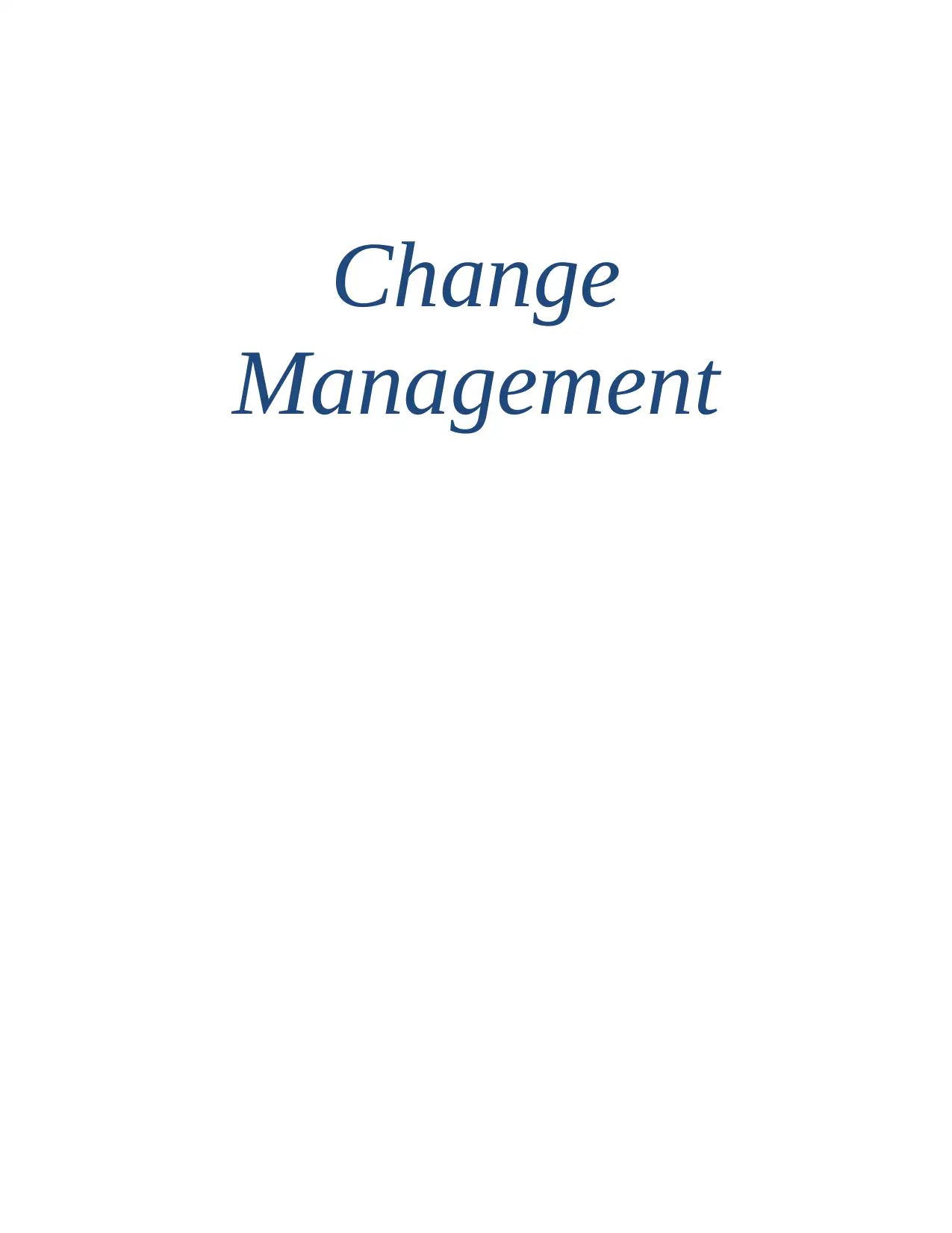
Change
Management
Management
Paraphrase This Document
Need a fresh take? Get an instant paraphrase of this document with our AI Paraphraser
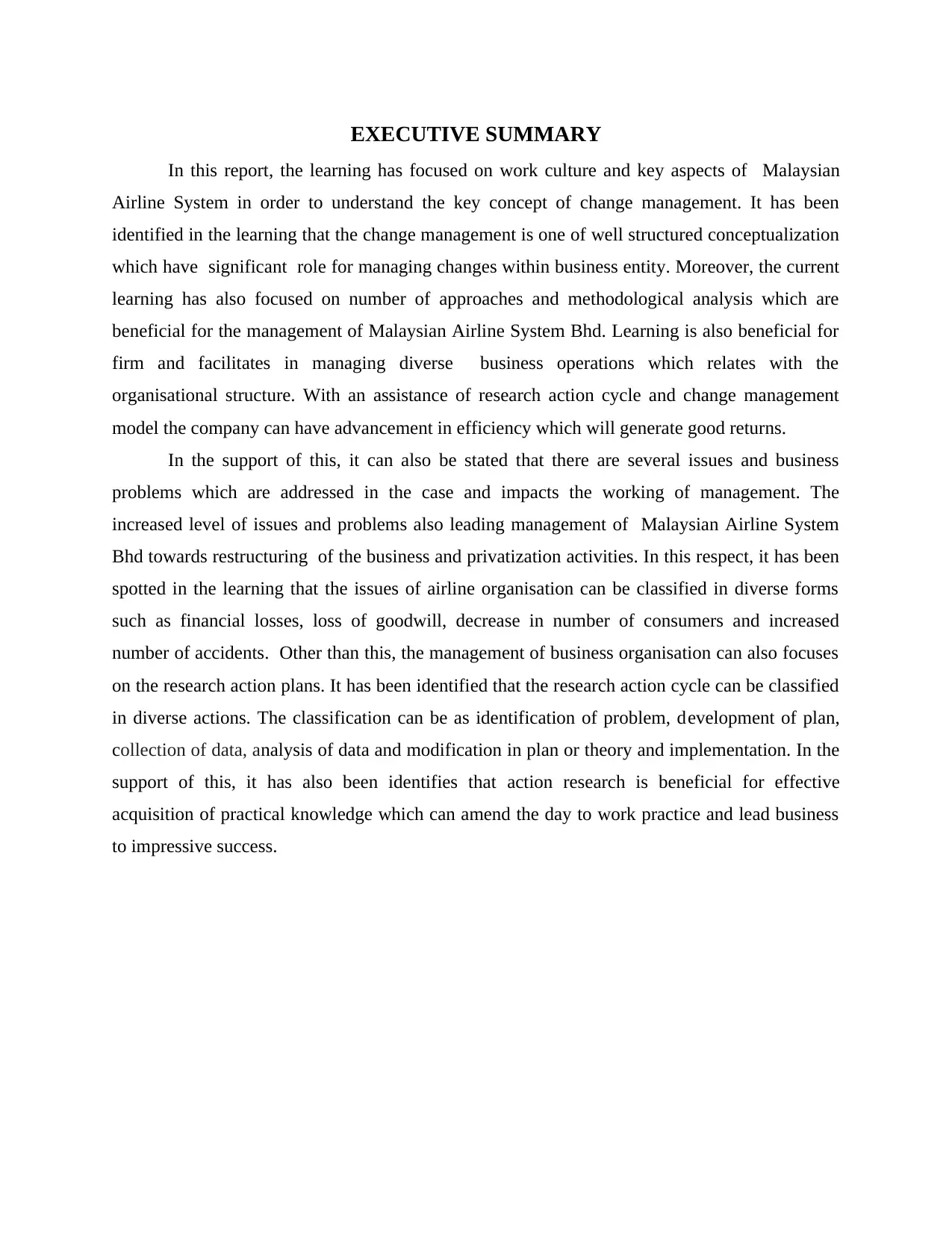
EXECUTIVE SUMMARY
In this report, the learning has focused on work culture and key aspects of Malaysian
Airline System in order to understand the key concept of change management. It has been
identified in the learning that the change management is one of well structured conceptualization
which have significant role for managing changes within business entity. Moreover, the current
learning has also focused on number of approaches and methodological analysis which are
beneficial for the management of Malaysian Airline System Bhd. Learning is also beneficial for
firm and facilitates in managing diverse business operations which relates with the
organisational structure. With an assistance of research action cycle and change management
model the company can have advancement in efficiency which will generate good returns.
In the support of this, it can also be stated that there are several issues and business
problems which are addressed in the case and impacts the working of management. The
increased level of issues and problems also leading management of Malaysian Airline System
Bhd towards restructuring of the business and privatization activities. In this respect, it has been
spotted in the learning that the issues of airline organisation can be classified in diverse forms
such as financial losses, loss of goodwill, decrease in number of consumers and increased
number of accidents. Other than this, the management of business organisation can also focuses
on the research action plans. It has been identified that the research action cycle can be classified
in diverse actions. The classification can be as identification of problem, development of plan,
collection of data, analysis of data and modification in plan or theory and implementation. In the
support of this, it has also been identifies that action research is beneficial for effective
acquisition of practical knowledge which can amend the day to work practice and lead business
to impressive success.
In this report, the learning has focused on work culture and key aspects of Malaysian
Airline System in order to understand the key concept of change management. It has been
identified in the learning that the change management is one of well structured conceptualization
which have significant role for managing changes within business entity. Moreover, the current
learning has also focused on number of approaches and methodological analysis which are
beneficial for the management of Malaysian Airline System Bhd. Learning is also beneficial for
firm and facilitates in managing diverse business operations which relates with the
organisational structure. With an assistance of research action cycle and change management
model the company can have advancement in efficiency which will generate good returns.
In the support of this, it can also be stated that there are several issues and business
problems which are addressed in the case and impacts the working of management. The
increased level of issues and problems also leading management of Malaysian Airline System
Bhd towards restructuring of the business and privatization activities. In this respect, it has been
spotted in the learning that the issues of airline organisation can be classified in diverse forms
such as financial losses, loss of goodwill, decrease in number of consumers and increased
number of accidents. Other than this, the management of business organisation can also focuses
on the research action plans. It has been identified that the research action cycle can be classified
in diverse actions. The classification can be as identification of problem, development of plan,
collection of data, analysis of data and modification in plan or theory and implementation. In the
support of this, it has also been identifies that action research is beneficial for effective
acquisition of practical knowledge which can amend the day to work practice and lead business
to impressive success.
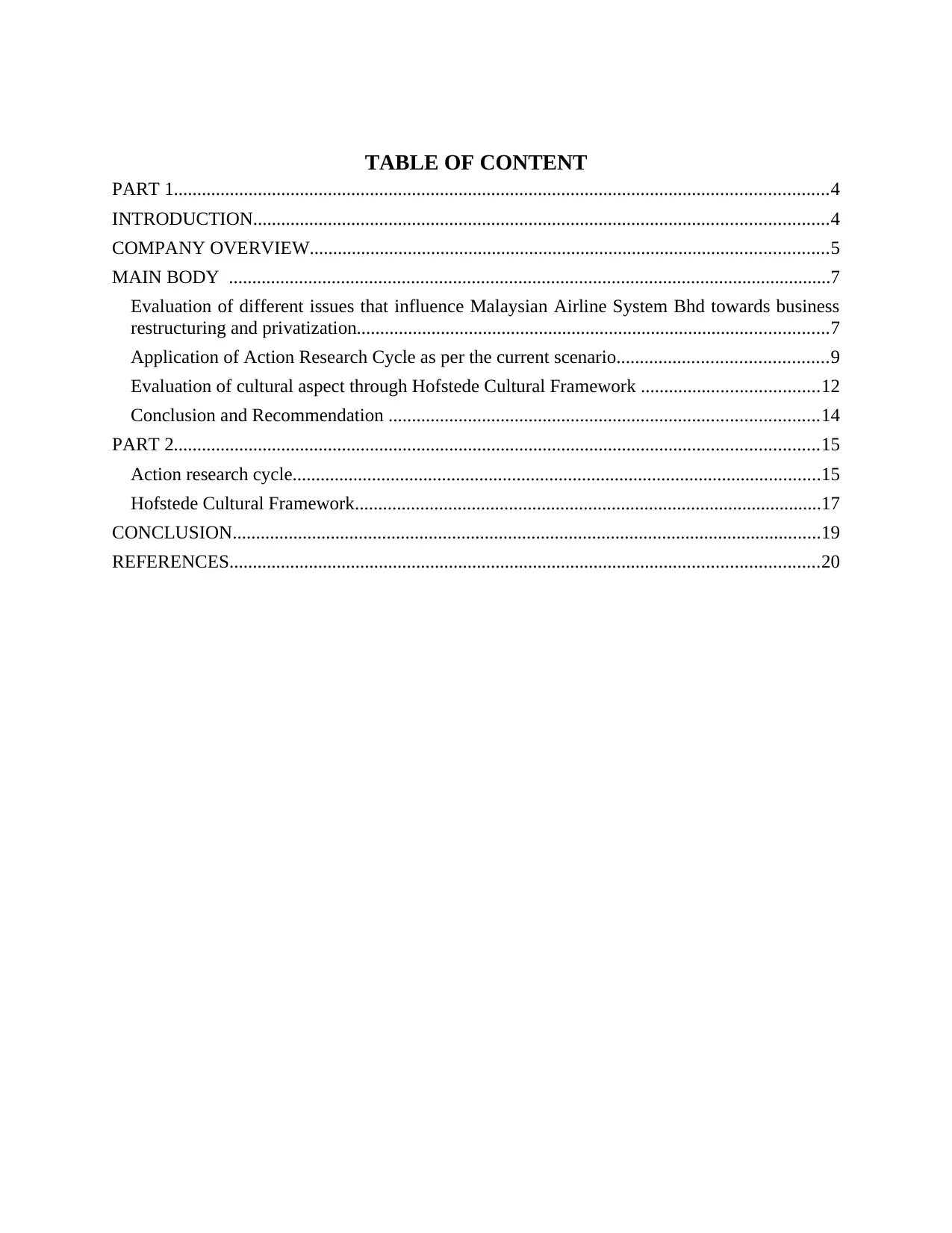
TABLE OF CONTENT
PART 1............................................................................................................................................4
INTRODUCTION...........................................................................................................................4
COMPANY OVERVIEW...............................................................................................................5
MAIN BODY .................................................................................................................................7
Evaluation of different issues that influence Malaysian Airline System Bhd towards business
restructuring and privatization.....................................................................................................7
Application of Action Research Cycle as per the current scenario.............................................9
Evaluation of cultural aspect through Hofstede Cultural Framework ......................................12
Conclusion and Recommendation ............................................................................................14
PART 2..........................................................................................................................................15
Action research cycle.................................................................................................................15
Hofstede Cultural Framework....................................................................................................17
CONCLUSION..............................................................................................................................19
REFERENCES..............................................................................................................................20
PART 1............................................................................................................................................4
INTRODUCTION...........................................................................................................................4
COMPANY OVERVIEW...............................................................................................................5
MAIN BODY .................................................................................................................................7
Evaluation of different issues that influence Malaysian Airline System Bhd towards business
restructuring and privatization.....................................................................................................7
Application of Action Research Cycle as per the current scenario.............................................9
Evaluation of cultural aspect through Hofstede Cultural Framework ......................................12
Conclusion and Recommendation ............................................................................................14
PART 2..........................................................................................................................................15
Action research cycle.................................................................................................................15
Hofstede Cultural Framework....................................................................................................17
CONCLUSION..............................................................................................................................19
REFERENCES..............................................................................................................................20
⊘ This is a preview!⊘
Do you want full access?
Subscribe today to unlock all pages.

Trusted by 1+ million students worldwide
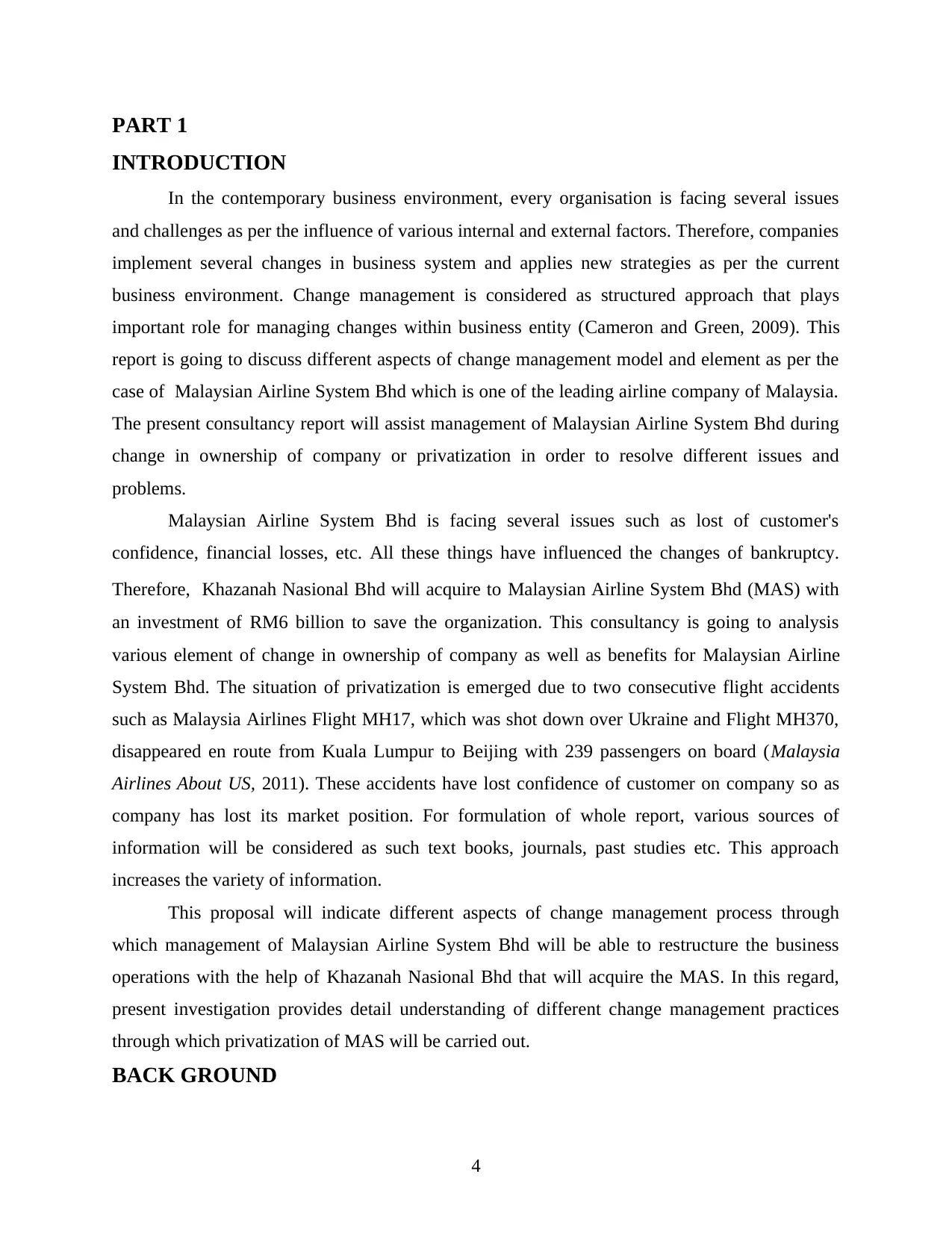
PART 1
INTRODUCTION
In the contemporary business environment, every organisation is facing several issues
and challenges as per the influence of various internal and external factors. Therefore, companies
implement several changes in business system and applies new strategies as per the current
business environment. Change management is considered as structured approach that plays
important role for managing changes within business entity (Cameron and Green, 2009). This
report is going to discuss different aspects of change management model and element as per the
case of Malaysian Airline System Bhd which is one of the leading airline company of Malaysia.
The present consultancy report will assist management of Malaysian Airline System Bhd during
change in ownership of company or privatization in order to resolve different issues and
problems.
Malaysian Airline System Bhd is facing several issues such as lost of customer's
confidence, financial losses, etc. All these things have influenced the changes of bankruptcy.
Therefore, Khazanah Nasional Bhd will acquire to Malaysian Airline System Bhd (MAS) with
an investment of RM6 billion to save the organization. This consultancy is going to analysis
various element of change in ownership of company as well as benefits for Malaysian Airline
System Bhd. The situation of privatization is emerged due to two consecutive flight accidents
such as Malaysia Airlines Flight MH17, which was shot down over Ukraine and Flight MH370,
disappeared en route from Kuala Lumpur to Beijing with 239 passengers on board (Malaysia
Airlines About US, 2011). These accidents have lost confidence of customer on company so as
company has lost its market position. For formulation of whole report, various sources of
information will be considered as such text books, journals, past studies etc. This approach
increases the variety of information.
This proposal will indicate different aspects of change management process through
which management of Malaysian Airline System Bhd will be able to restructure the business
operations with the help of Khazanah Nasional Bhd that will acquire the MAS. In this regard,
present investigation provides detail understanding of different change management practices
through which privatization of MAS will be carried out.
BACK GROUND
4
INTRODUCTION
In the contemporary business environment, every organisation is facing several issues
and challenges as per the influence of various internal and external factors. Therefore, companies
implement several changes in business system and applies new strategies as per the current
business environment. Change management is considered as structured approach that plays
important role for managing changes within business entity (Cameron and Green, 2009). This
report is going to discuss different aspects of change management model and element as per the
case of Malaysian Airline System Bhd which is one of the leading airline company of Malaysia.
The present consultancy report will assist management of Malaysian Airline System Bhd during
change in ownership of company or privatization in order to resolve different issues and
problems.
Malaysian Airline System Bhd is facing several issues such as lost of customer's
confidence, financial losses, etc. All these things have influenced the changes of bankruptcy.
Therefore, Khazanah Nasional Bhd will acquire to Malaysian Airline System Bhd (MAS) with
an investment of RM6 billion to save the organization. This consultancy is going to analysis
various element of change in ownership of company as well as benefits for Malaysian Airline
System Bhd. The situation of privatization is emerged due to two consecutive flight accidents
such as Malaysia Airlines Flight MH17, which was shot down over Ukraine and Flight MH370,
disappeared en route from Kuala Lumpur to Beijing with 239 passengers on board (Malaysia
Airlines About US, 2011). These accidents have lost confidence of customer on company so as
company has lost its market position. For formulation of whole report, various sources of
information will be considered as such text books, journals, past studies etc. This approach
increases the variety of information.
This proposal will indicate different aspects of change management process through
which management of Malaysian Airline System Bhd will be able to restructure the business
operations with the help of Khazanah Nasional Bhd that will acquire the MAS. In this regard,
present investigation provides detail understanding of different change management practices
through which privatization of MAS will be carried out.
BACK GROUND
4
Paraphrase This Document
Need a fresh take? Get an instant paraphrase of this document with our AI Paraphraser
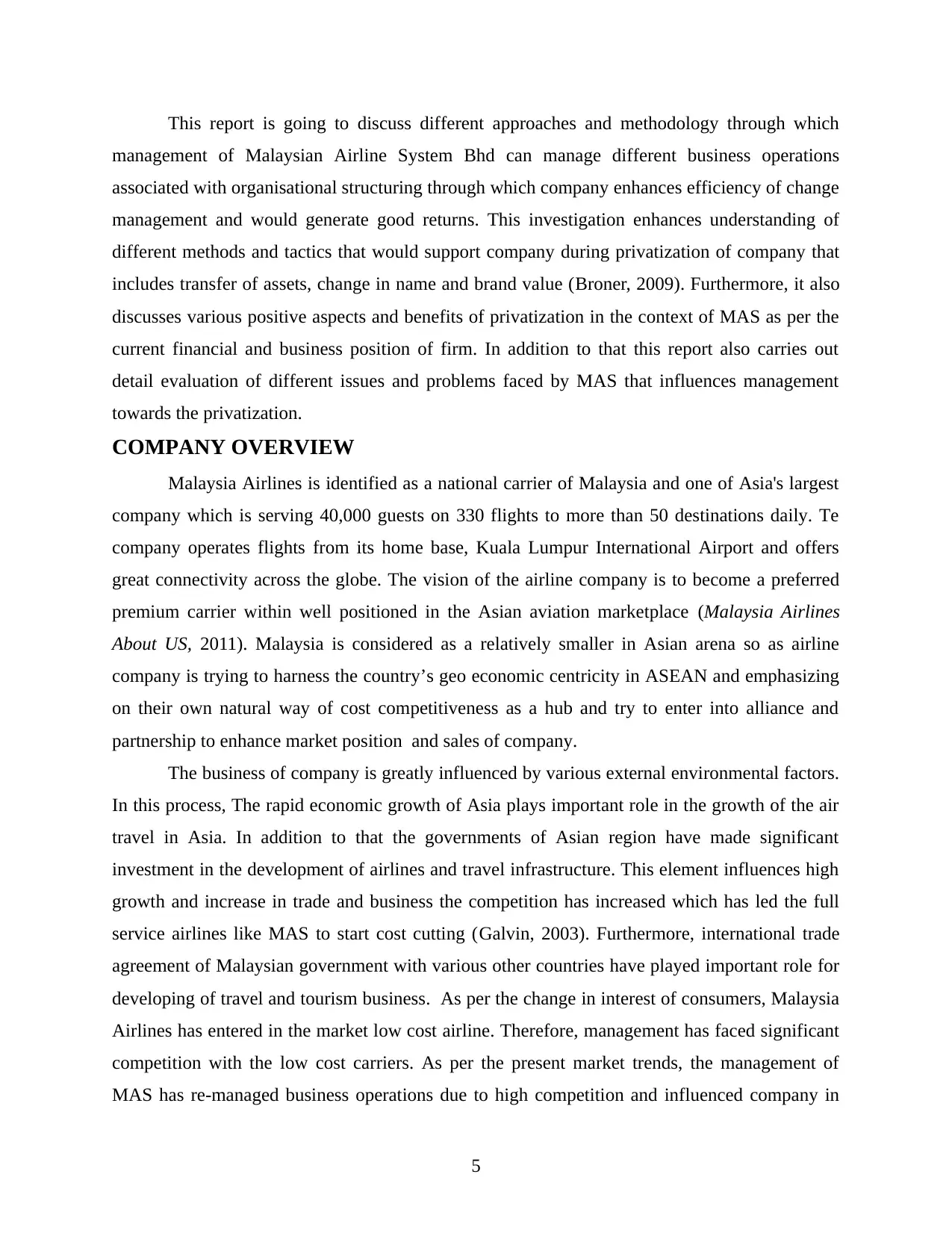
This report is going to discuss different approaches and methodology through which
management of Malaysian Airline System Bhd can manage different business operations
associated with organisational structuring through which company enhances efficiency of change
management and would generate good returns. This investigation enhances understanding of
different methods and tactics that would support company during privatization of company that
includes transfer of assets, change in name and brand value (Broner, 2009). Furthermore, it also
discusses various positive aspects and benefits of privatization in the context of MAS as per the
current financial and business position of firm. In addition to that this report also carries out
detail evaluation of different issues and problems faced by MAS that influences management
towards the privatization.
COMPANY OVERVIEW
Malaysia Airlines is identified as a national carrier of Malaysia and one of Asia's largest
company which is serving 40,000 guests on 330 flights to more than 50 destinations daily. Te
company operates flights from its home base, Kuala Lumpur International Airport and offers
great connectivity across the globe. The vision of the airline company is to become a preferred
premium carrier within well positioned in the Asian aviation marketplace (Malaysia Airlines
About US, 2011). Malaysia is considered as a relatively smaller in Asian arena so as airline
company is trying to harness the country’s geo economic centricity in ASEAN and emphasizing
on their own natural way of cost competitiveness as a hub and try to enter into alliance and
partnership to enhance market position and sales of company.
The business of company is greatly influenced by various external environmental factors.
In this process, The rapid economic growth of Asia plays important role in the growth of the air
travel in Asia. In addition to that the governments of Asian region have made significant
investment in the development of airlines and travel infrastructure. This element influences high
growth and increase in trade and business the competition has increased which has led the full
service airlines like MAS to start cost cutting (Galvin, 2003). Furthermore, international trade
agreement of Malaysian government with various other countries have played important role for
developing of travel and tourism business. As per the change in interest of consumers, Malaysia
Airlines has entered in the market low cost airline. Therefore, management has faced significant
competition with the low cost carriers. As per the present market trends, the management of
MAS has re-managed business operations due to high competition and influenced company in
5
management of Malaysian Airline System Bhd can manage different business operations
associated with organisational structuring through which company enhances efficiency of change
management and would generate good returns. This investigation enhances understanding of
different methods and tactics that would support company during privatization of company that
includes transfer of assets, change in name and brand value (Broner, 2009). Furthermore, it also
discusses various positive aspects and benefits of privatization in the context of MAS as per the
current financial and business position of firm. In addition to that this report also carries out
detail evaluation of different issues and problems faced by MAS that influences management
towards the privatization.
COMPANY OVERVIEW
Malaysia Airlines is identified as a national carrier of Malaysia and one of Asia's largest
company which is serving 40,000 guests on 330 flights to more than 50 destinations daily. Te
company operates flights from its home base, Kuala Lumpur International Airport and offers
great connectivity across the globe. The vision of the airline company is to become a preferred
premium carrier within well positioned in the Asian aviation marketplace (Malaysia Airlines
About US, 2011). Malaysia is considered as a relatively smaller in Asian arena so as airline
company is trying to harness the country’s geo economic centricity in ASEAN and emphasizing
on their own natural way of cost competitiveness as a hub and try to enter into alliance and
partnership to enhance market position and sales of company.
The business of company is greatly influenced by various external environmental factors.
In this process, The rapid economic growth of Asia plays important role in the growth of the air
travel in Asia. In addition to that the governments of Asian region have made significant
investment in the development of airlines and travel infrastructure. This element influences high
growth and increase in trade and business the competition has increased which has led the full
service airlines like MAS to start cost cutting (Galvin, 2003). Furthermore, international trade
agreement of Malaysian government with various other countries have played important role for
developing of travel and tourism business. As per the change in interest of consumers, Malaysia
Airlines has entered in the market low cost airline. Therefore, management has faced significant
competition with the low cost carriers. As per the present market trends, the management of
MAS has re-managed business operations due to high competition and influenced company in
5
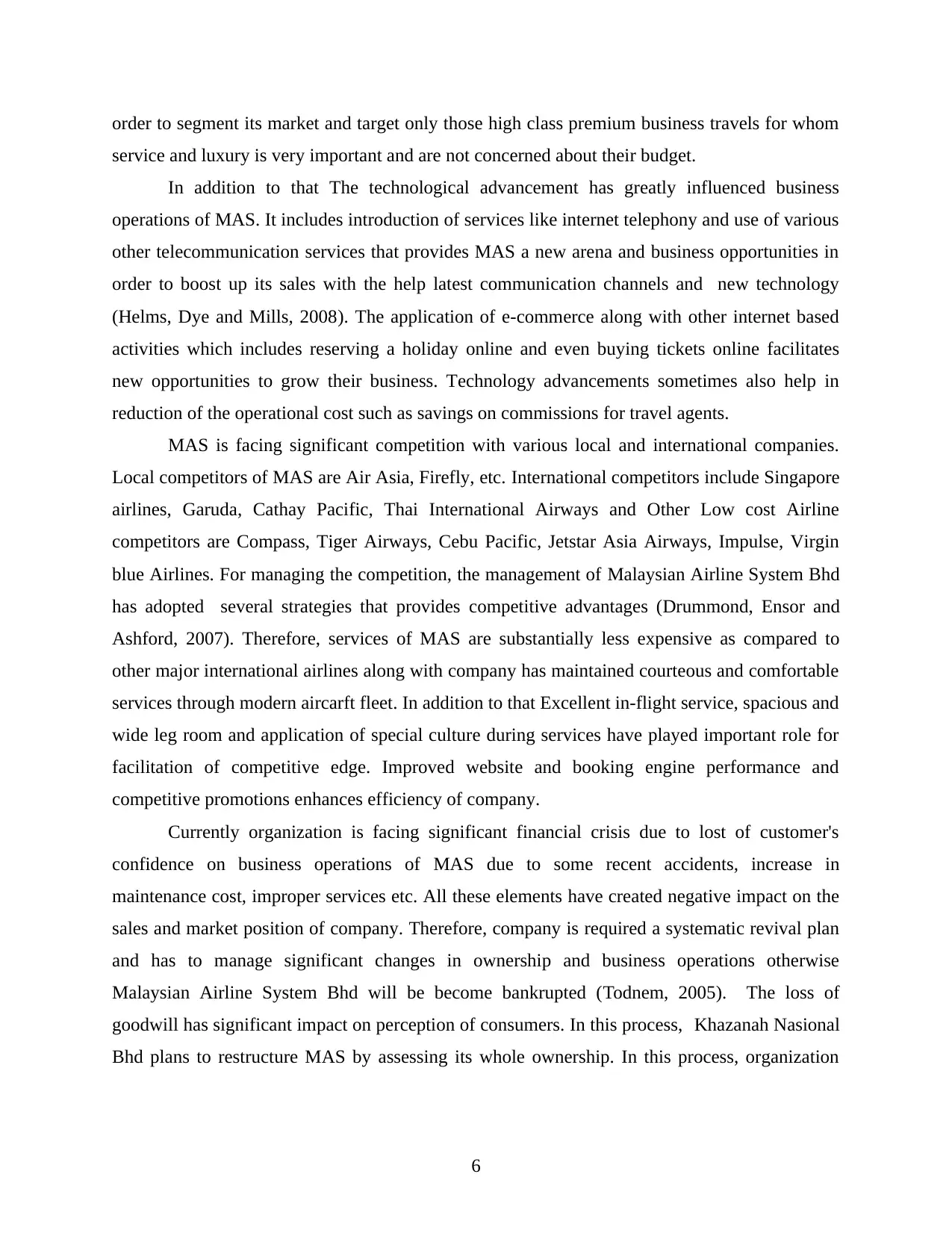
order to segment its market and target only those high class premium business travels for whom
service and luxury is very important and are not concerned about their budget.
In addition to that The technological advancement has greatly influenced business
operations of MAS. It includes introduction of services like internet telephony and use of various
other telecommunication services that provides MAS a new arena and business opportunities in
order to boost up its sales with the help latest communication channels and new technology
(Helms, Dye and Mills, 2008). The application of e-commerce along with other internet based
activities which includes reserving a holiday online and even buying tickets online facilitates
new opportunities to grow their business. Technology advancements sometimes also help in
reduction of the operational cost such as savings on commissions for travel agents.
MAS is facing significant competition with various local and international companies.
Local competitors of MAS are Air Asia, Firefly, etc. International competitors include Singapore
airlines, Garuda, Cathay Pacific, Thai International Airways and Other Low cost Airline
competitors are Compass, Tiger Airways, Cebu Pacific, Jetstar Asia Airways, Impulse, Virgin
blue Airlines. For managing the competition, the management of Malaysian Airline System Bhd
has adopted several strategies that provides competitive advantages (Drummond, Ensor and
Ashford, 2007). Therefore, services of MAS are substantially less expensive as compared to
other major international airlines along with company has maintained courteous and comfortable
services through modern aircarft fleet. In addition to that Excellent in-flight service, spacious and
wide leg room and application of special culture during services have played important role for
facilitation of competitive edge. Improved website and booking engine performance and
competitive promotions enhances efficiency of company.
Currently organization is facing significant financial crisis due to lost of customer's
confidence on business operations of MAS due to some recent accidents, increase in
maintenance cost, improper services etc. All these elements have created negative impact on the
sales and market position of company. Therefore, company is required a systematic revival plan
and has to manage significant changes in ownership and business operations otherwise
Malaysian Airline System Bhd will be become bankrupted (Todnem, 2005). The loss of
goodwill has significant impact on perception of consumers. In this process, Khazanah Nasional
Bhd plans to restructure MAS by assessing its whole ownership. In this process, organization
6
service and luxury is very important and are not concerned about their budget.
In addition to that The technological advancement has greatly influenced business
operations of MAS. It includes introduction of services like internet telephony and use of various
other telecommunication services that provides MAS a new arena and business opportunities in
order to boost up its sales with the help latest communication channels and new technology
(Helms, Dye and Mills, 2008). The application of e-commerce along with other internet based
activities which includes reserving a holiday online and even buying tickets online facilitates
new opportunities to grow their business. Technology advancements sometimes also help in
reduction of the operational cost such as savings on commissions for travel agents.
MAS is facing significant competition with various local and international companies.
Local competitors of MAS are Air Asia, Firefly, etc. International competitors include Singapore
airlines, Garuda, Cathay Pacific, Thai International Airways and Other Low cost Airline
competitors are Compass, Tiger Airways, Cebu Pacific, Jetstar Asia Airways, Impulse, Virgin
blue Airlines. For managing the competition, the management of Malaysian Airline System Bhd
has adopted several strategies that provides competitive advantages (Drummond, Ensor and
Ashford, 2007). Therefore, services of MAS are substantially less expensive as compared to
other major international airlines along with company has maintained courteous and comfortable
services through modern aircarft fleet. In addition to that Excellent in-flight service, spacious and
wide leg room and application of special culture during services have played important role for
facilitation of competitive edge. Improved website and booking engine performance and
competitive promotions enhances efficiency of company.
Currently organization is facing significant financial crisis due to lost of customer's
confidence on business operations of MAS due to some recent accidents, increase in
maintenance cost, improper services etc. All these elements have created negative impact on the
sales and market position of company. Therefore, company is required a systematic revival plan
and has to manage significant changes in ownership and business operations otherwise
Malaysian Airline System Bhd will be become bankrupted (Todnem, 2005). The loss of
goodwill has significant impact on perception of consumers. In this process, Khazanah Nasional
Bhd plans to restructure MAS by assessing its whole ownership. In this process, organization
6
⊘ This is a preview!⊘
Do you want full access?
Subscribe today to unlock all pages.

Trusted by 1+ million students worldwide
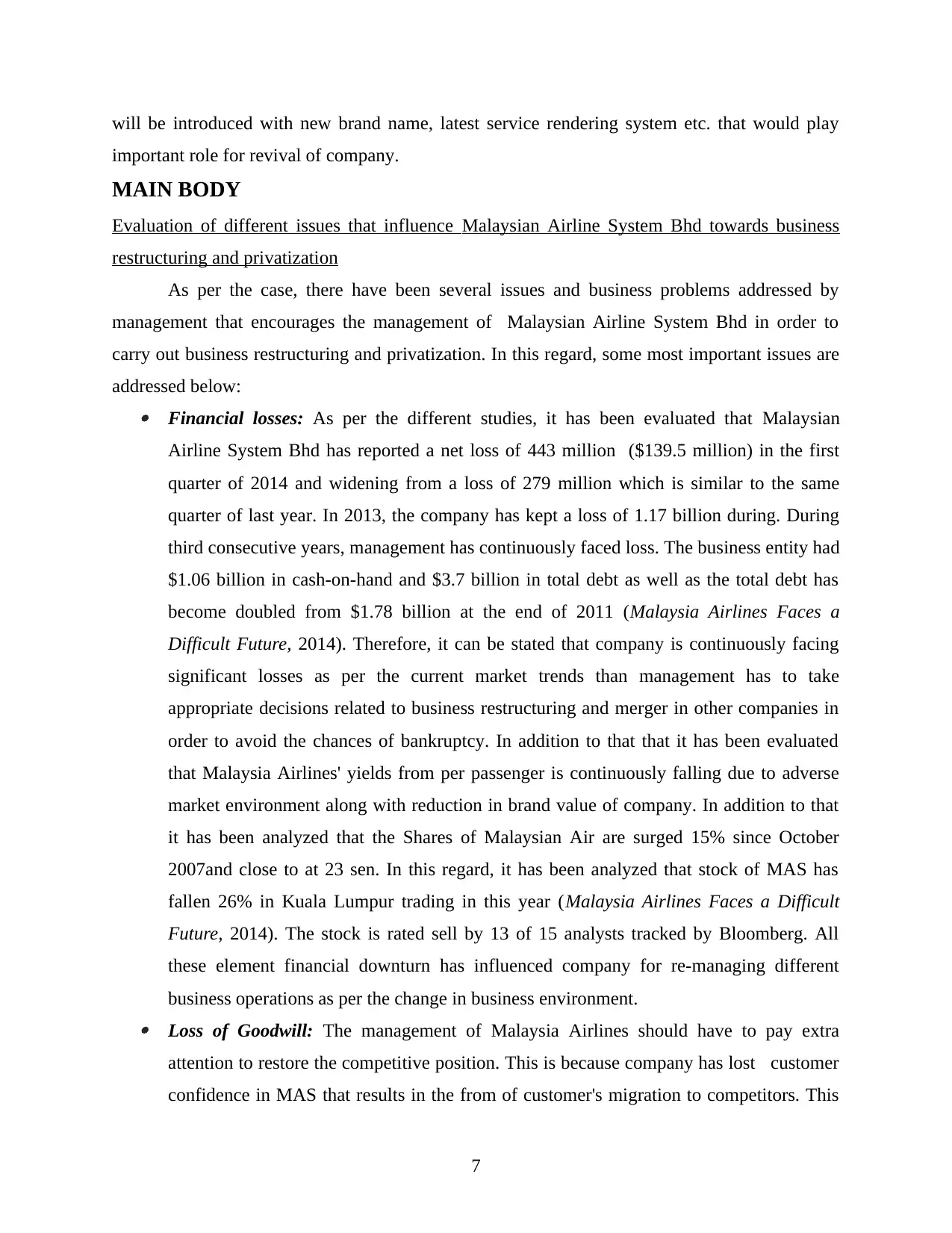
will be introduced with new brand name, latest service rendering system etc. that would play
important role for revival of company.
MAIN BODY
Evaluation of different issues that influence Malaysian Airline System Bhd towards business
restructuring and privatization
As per the case, there have been several issues and business problems addressed by
management that encourages the management of Malaysian Airline System Bhd in order to
carry out business restructuring and privatization. In this regard, some most important issues are
addressed below: Financial losses: As per the different studies, it has been evaluated that Malaysian
Airline System Bhd has reported a net loss of 443 million ($139.5 million) in the first
quarter of 2014 and widening from a loss of 279 million which is similar to the same
quarter of last year. In 2013, the company has kept a loss of 1.17 billion during. During
third consecutive years, management has continuously faced loss. The business entity had
$1.06 billion in cash-on-hand and $3.7 billion in total debt as well as the total debt has
become doubled from $1.78 billion at the end of 2011 (Malaysia Airlines Faces a
Difficult Future, 2014). Therefore, it can be stated that company is continuously facing
significant losses as per the current market trends than management has to take
appropriate decisions related to business restructuring and merger in other companies in
order to avoid the chances of bankruptcy. In addition to that that it has been evaluated
that Malaysia Airlines' yields from per passenger is continuously falling due to adverse
market environment along with reduction in brand value of company. In addition to that
it has been analyzed that the Shares of Malaysian Air are surged 15% since October
2007and close to at 23 sen. In this regard, it has been analyzed that stock of MAS has
fallen 26% in Kuala Lumpur trading in this year (Malaysia Airlines Faces a Difficult
Future, 2014). The stock is rated sell by 13 of 15 analysts tracked by Bloomberg. All
these element financial downturn has influenced company for re-managing different
business operations as per the change in business environment. Loss of Goodwill: The management of Malaysia Airlines should have to pay extra
attention to restore the competitive position. This is because company has lost customer
confidence in MAS that results in the from of customer's migration to competitors. This
7
important role for revival of company.
MAIN BODY
Evaluation of different issues that influence Malaysian Airline System Bhd towards business
restructuring and privatization
As per the case, there have been several issues and business problems addressed by
management that encourages the management of Malaysian Airline System Bhd in order to
carry out business restructuring and privatization. In this regard, some most important issues are
addressed below: Financial losses: As per the different studies, it has been evaluated that Malaysian
Airline System Bhd has reported a net loss of 443 million ($139.5 million) in the first
quarter of 2014 and widening from a loss of 279 million which is similar to the same
quarter of last year. In 2013, the company has kept a loss of 1.17 billion during. During
third consecutive years, management has continuously faced loss. The business entity had
$1.06 billion in cash-on-hand and $3.7 billion in total debt as well as the total debt has
become doubled from $1.78 billion at the end of 2011 (Malaysia Airlines Faces a
Difficult Future, 2014). Therefore, it can be stated that company is continuously facing
significant losses as per the current market trends than management has to take
appropriate decisions related to business restructuring and merger in other companies in
order to avoid the chances of bankruptcy. In addition to that that it has been evaluated
that Malaysia Airlines' yields from per passenger is continuously falling due to adverse
market environment along with reduction in brand value of company. In addition to that
it has been analyzed that the Shares of Malaysian Air are surged 15% since October
2007and close to at 23 sen. In this regard, it has been analyzed that stock of MAS has
fallen 26% in Kuala Lumpur trading in this year (Malaysia Airlines Faces a Difficult
Future, 2014). The stock is rated sell by 13 of 15 analysts tracked by Bloomberg. All
these element financial downturn has influenced company for re-managing different
business operations as per the change in business environment. Loss of Goodwill: The management of Malaysia Airlines should have to pay extra
attention to restore the competitive position. This is because company has lost customer
confidence in MAS that results in the from of customer's migration to competitors. This
7
Paraphrase This Document
Need a fresh take? Get an instant paraphrase of this document with our AI Paraphraser
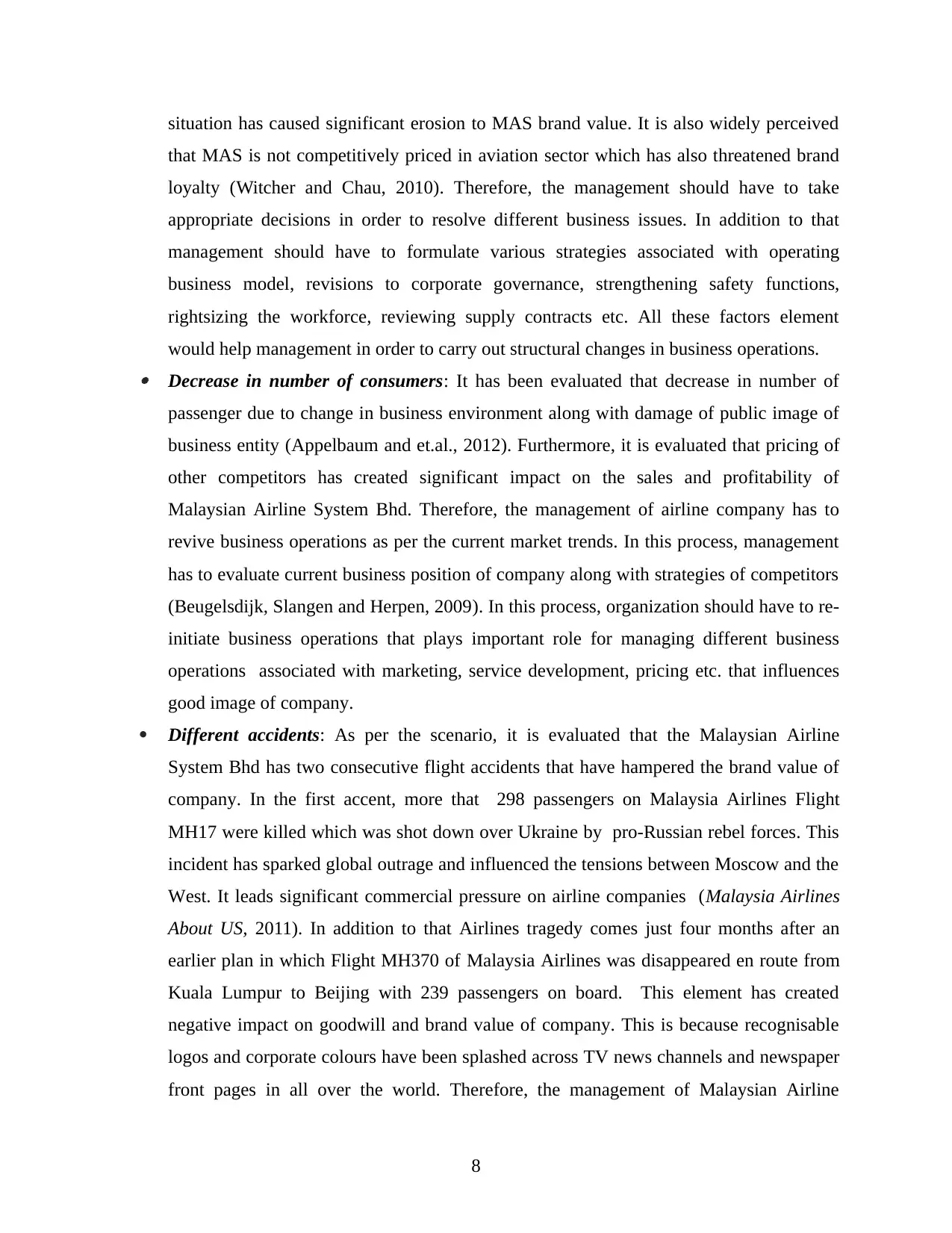
situation has caused significant erosion to MAS brand value. It is also widely perceived
that MAS is not competitively priced in aviation sector which has also threatened brand
loyalty (Witcher and Chau, 2010). Therefore, the management should have to take
appropriate decisions in order to resolve different business issues. In addition to that
management should have to formulate various strategies associated with operating
business model, revisions to corporate governance, strengthening safety functions,
rightsizing the workforce, reviewing supply contracts etc. All these factors element
would help management in order to carry out structural changes in business operations. Decrease in number of consumers: It has been evaluated that decrease in number of
passenger due to change in business environment along with damage of public image of
business entity (Appelbaum and et.al., 2012). Furthermore, it is evaluated that pricing of
other competitors has created significant impact on the sales and profitability of
Malaysian Airline System Bhd. Therefore, the management of airline company has to
revive business operations as per the current market trends. In this process, management
has to evaluate current business position of company along with strategies of competitors
(Beugelsdijk, Slangen and Herpen, 2009). In this process, organization should have to re-
initiate business operations that plays important role for managing different business
operations associated with marketing, service development, pricing etc. that influences
good image of company.
Different accidents: As per the scenario, it is evaluated that the Malaysian Airline
System Bhd has two consecutive flight accidents that have hampered the brand value of
company. In the first accent, more that 298 passengers on Malaysia Airlines Flight
MH17 were killed which was shot down over Ukraine by pro-Russian rebel forces. This
incident has sparked global outrage and influenced the tensions between Moscow and the
West. It leads significant commercial pressure on airline companies (Malaysia Airlines
About US, 2011). In addition to that Airlines tragedy comes just four months after an
earlier plan in which Flight MH370 of Malaysia Airlines was disappeared en route from
Kuala Lumpur to Beijing with 239 passengers on board. This element has created
negative impact on goodwill and brand value of company. This is because recognisable
logos and corporate colours have been splashed across TV news channels and newspaper
front pages in all over the world. Therefore, the management of Malaysian Airline
8
that MAS is not competitively priced in aviation sector which has also threatened brand
loyalty (Witcher and Chau, 2010). Therefore, the management should have to take
appropriate decisions in order to resolve different business issues. In addition to that
management should have to formulate various strategies associated with operating
business model, revisions to corporate governance, strengthening safety functions,
rightsizing the workforce, reviewing supply contracts etc. All these factors element
would help management in order to carry out structural changes in business operations. Decrease in number of consumers: It has been evaluated that decrease in number of
passenger due to change in business environment along with damage of public image of
business entity (Appelbaum and et.al., 2012). Furthermore, it is evaluated that pricing of
other competitors has created significant impact on the sales and profitability of
Malaysian Airline System Bhd. Therefore, the management of airline company has to
revive business operations as per the current market trends. In this process, management
has to evaluate current business position of company along with strategies of competitors
(Beugelsdijk, Slangen and Herpen, 2009). In this process, organization should have to re-
initiate business operations that plays important role for managing different business
operations associated with marketing, service development, pricing etc. that influences
good image of company.
Different accidents: As per the scenario, it is evaluated that the Malaysian Airline
System Bhd has two consecutive flight accidents that have hampered the brand value of
company. In the first accent, more that 298 passengers on Malaysia Airlines Flight
MH17 were killed which was shot down over Ukraine by pro-Russian rebel forces. This
incident has sparked global outrage and influenced the tensions between Moscow and the
West. It leads significant commercial pressure on airline companies (Malaysia Airlines
About US, 2011). In addition to that Airlines tragedy comes just four months after an
earlier plan in which Flight MH370 of Malaysia Airlines was disappeared en route from
Kuala Lumpur to Beijing with 239 passengers on board. This element has created
negative impact on goodwill and brand value of company. This is because recognisable
logos and corporate colours have been splashed across TV news channels and newspaper
front pages in all over the world. Therefore, the management of Malaysian Airline
8
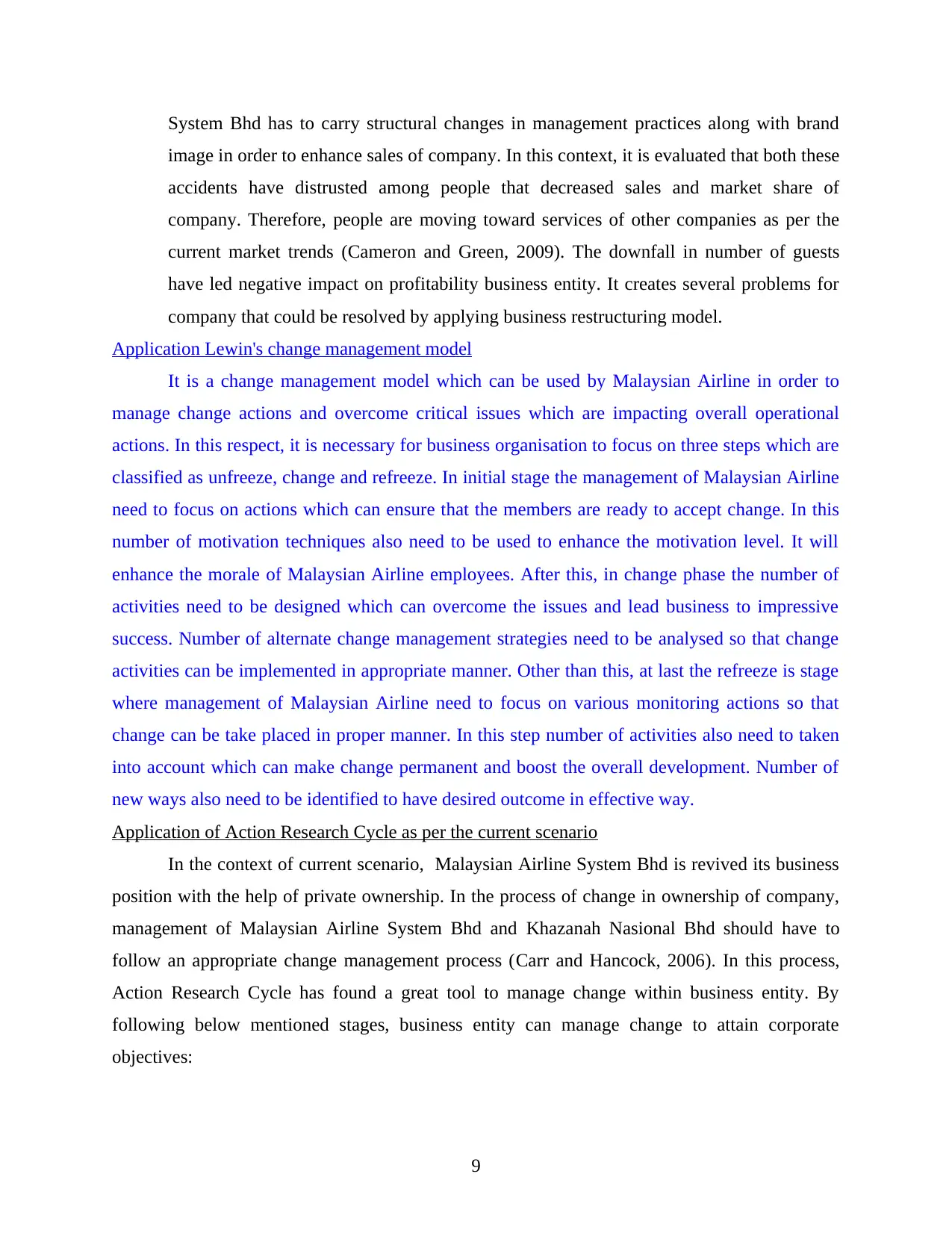
System Bhd has to carry structural changes in management practices along with brand
image in order to enhance sales of company. In this context, it is evaluated that both these
accidents have distrusted among people that decreased sales and market share of
company. Therefore, people are moving toward services of other companies as per the
current market trends (Cameron and Green, 2009). The downfall in number of guests
have led negative impact on profitability business entity. It creates several problems for
company that could be resolved by applying business restructuring model.
Application Lewin's change management model
It is a change management model which can be used by Malaysian Airline in order to
manage change actions and overcome critical issues which are impacting overall operational
actions. In this respect, it is necessary for business organisation to focus on three steps which are
classified as unfreeze, change and refreeze. In initial stage the management of Malaysian Airline
need to focus on actions which can ensure that the members are ready to accept change. In this
number of motivation techniques also need to be used to enhance the motivation level. It will
enhance the morale of Malaysian Airline employees. After this, in change phase the number of
activities need to be designed which can overcome the issues and lead business to impressive
success. Number of alternate change management strategies need to be analysed so that change
activities can be implemented in appropriate manner. Other than this, at last the refreeze is stage
where management of Malaysian Airline need to focus on various monitoring actions so that
change can be take placed in proper manner. In this step number of activities also need to taken
into account which can make change permanent and boost the overall development. Number of
new ways also need to be identified to have desired outcome in effective way.
Application of Action Research Cycle as per the current scenario
In the context of current scenario, Malaysian Airline System Bhd is revived its business
position with the help of private ownership. In the process of change in ownership of company,
management of Malaysian Airline System Bhd and Khazanah Nasional Bhd should have to
follow an appropriate change management process (Carr and Hancock, 2006). In this process,
Action Research Cycle has found a great tool to manage change within business entity. By
following below mentioned stages, business entity can manage change to attain corporate
objectives:
9
image in order to enhance sales of company. In this context, it is evaluated that both these
accidents have distrusted among people that decreased sales and market share of
company. Therefore, people are moving toward services of other companies as per the
current market trends (Cameron and Green, 2009). The downfall in number of guests
have led negative impact on profitability business entity. It creates several problems for
company that could be resolved by applying business restructuring model.
Application Lewin's change management model
It is a change management model which can be used by Malaysian Airline in order to
manage change actions and overcome critical issues which are impacting overall operational
actions. In this respect, it is necessary for business organisation to focus on three steps which are
classified as unfreeze, change and refreeze. In initial stage the management of Malaysian Airline
need to focus on actions which can ensure that the members are ready to accept change. In this
number of motivation techniques also need to be used to enhance the motivation level. It will
enhance the morale of Malaysian Airline employees. After this, in change phase the number of
activities need to be designed which can overcome the issues and lead business to impressive
success. Number of alternate change management strategies need to be analysed so that change
activities can be implemented in appropriate manner. Other than this, at last the refreeze is stage
where management of Malaysian Airline need to focus on various monitoring actions so that
change can be take placed in proper manner. In this step number of activities also need to taken
into account which can make change permanent and boost the overall development. Number of
new ways also need to be identified to have desired outcome in effective way.
Application of Action Research Cycle as per the current scenario
In the context of current scenario, Malaysian Airline System Bhd is revived its business
position with the help of private ownership. In the process of change in ownership of company,
management of Malaysian Airline System Bhd and Khazanah Nasional Bhd should have to
follow an appropriate change management process (Carr and Hancock, 2006). In this process,
Action Research Cycle has found a great tool to manage change within business entity. By
following below mentioned stages, business entity can manage change to attain corporate
objectives:
9
⊘ This is a preview!⊘
Do you want full access?
Subscribe today to unlock all pages.

Trusted by 1+ million students worldwide
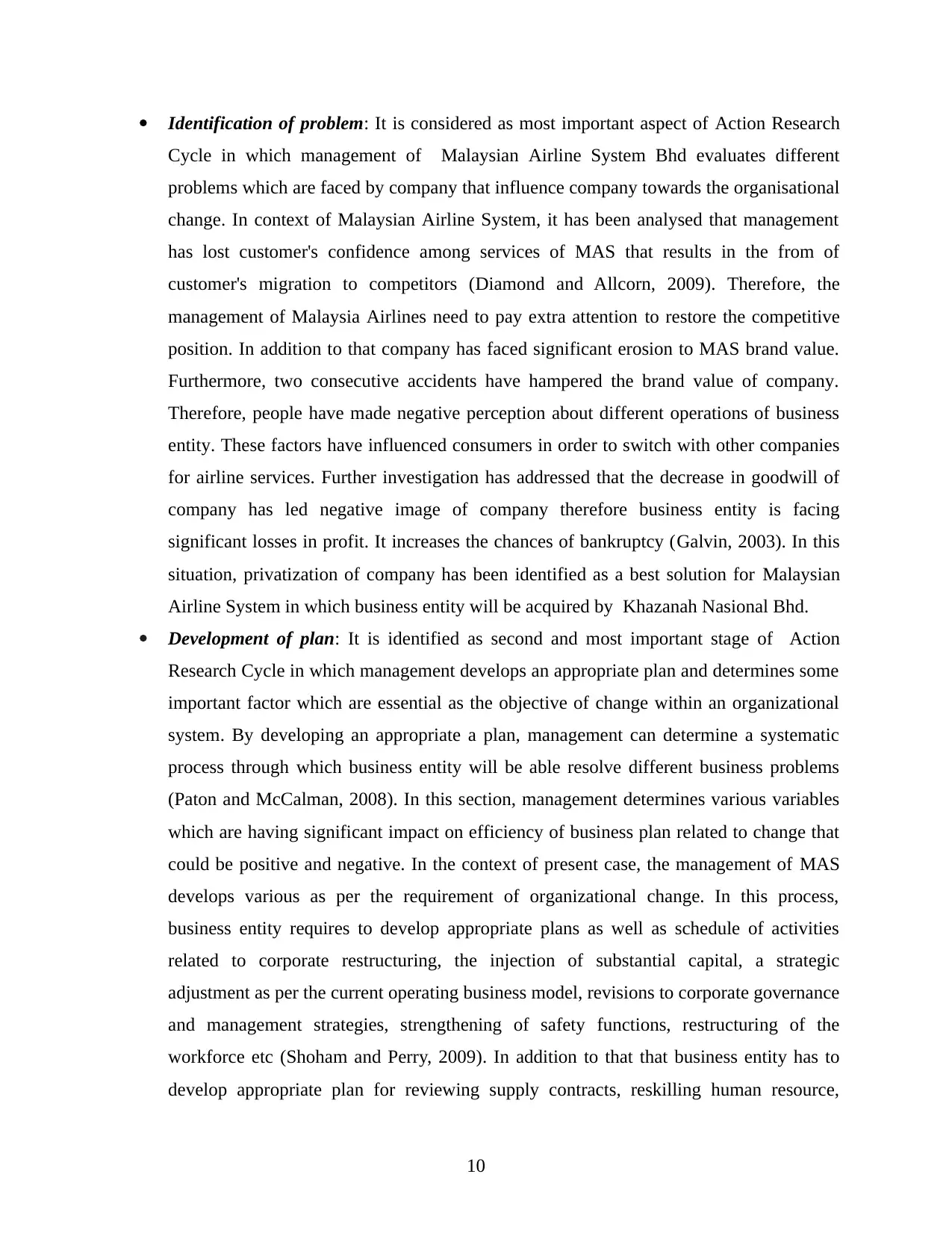
Identification of problem: It is considered as most important aspect of Action Research
Cycle in which management of Malaysian Airline System Bhd evaluates different
problems which are faced by company that influence company towards the organisational
change. In context of Malaysian Airline System, it has been analysed that management
has lost customer's confidence among services of MAS that results in the from of
customer's migration to competitors (Diamond and Allcorn, 2009). Therefore, the
management of Malaysia Airlines need to pay extra attention to restore the competitive
position. In addition to that company has faced significant erosion to MAS brand value.
Furthermore, two consecutive accidents have hampered the brand value of company.
Therefore, people have made negative perception about different operations of business
entity. These factors have influenced consumers in order to switch with other companies
for airline services. Further investigation has addressed that the decrease in goodwill of
company has led negative image of company therefore business entity is facing
significant losses in profit. It increases the chances of bankruptcy (Galvin, 2003). In this
situation, privatization of company has been identified as a best solution for Malaysian
Airline System in which business entity will be acquired by Khazanah Nasional Bhd.
Development of plan: It is identified as second and most important stage of Action
Research Cycle in which management develops an appropriate plan and determines some
important factor which are essential as the objective of change within an organizational
system. By developing an appropriate a plan, management can determine a systematic
process through which business entity will be able resolve different business problems
(Paton and McCalman, 2008). In this section, management determines various variables
which are having significant impact on efficiency of business plan related to change that
could be positive and negative. In the context of present case, the management of MAS
develops various as per the requirement of organizational change. In this process,
business entity requires to develop appropriate plans as well as schedule of activities
related to corporate restructuring, the injection of substantial capital, a strategic
adjustment as per the current operating business model, revisions to corporate governance
and management strategies, strengthening of safety functions, restructuring of the
workforce etc (Shoham and Perry, 2009). In addition to that that business entity has to
develop appropriate plan for reviewing supply contracts, reskilling human resource,
10
Cycle in which management of Malaysian Airline System Bhd evaluates different
problems which are faced by company that influence company towards the organisational
change. In context of Malaysian Airline System, it has been analysed that management
has lost customer's confidence among services of MAS that results in the from of
customer's migration to competitors (Diamond and Allcorn, 2009). Therefore, the
management of Malaysia Airlines need to pay extra attention to restore the competitive
position. In addition to that company has faced significant erosion to MAS brand value.
Furthermore, two consecutive accidents have hampered the brand value of company.
Therefore, people have made negative perception about different operations of business
entity. These factors have influenced consumers in order to switch with other companies
for airline services. Further investigation has addressed that the decrease in goodwill of
company has led negative image of company therefore business entity is facing
significant losses in profit. It increases the chances of bankruptcy (Galvin, 2003). In this
situation, privatization of company has been identified as a best solution for Malaysian
Airline System in which business entity will be acquired by Khazanah Nasional Bhd.
Development of plan: It is identified as second and most important stage of Action
Research Cycle in which management develops an appropriate plan and determines some
important factor which are essential as the objective of change within an organizational
system. By developing an appropriate a plan, management can determine a systematic
process through which business entity will be able resolve different business problems
(Paton and McCalman, 2008). In this section, management determines various variables
which are having significant impact on efficiency of business plan related to change that
could be positive and negative. In the context of present case, the management of MAS
develops various as per the requirement of organizational change. In this process,
business entity requires to develop appropriate plans as well as schedule of activities
related to corporate restructuring, the injection of substantial capital, a strategic
adjustment as per the current operating business model, revisions to corporate governance
and management strategies, strengthening of safety functions, restructuring of the
workforce etc (Shoham and Perry, 2009). In addition to that that business entity has to
develop appropriate plan for reviewing supply contracts, reskilling human resource,
10
Paraphrase This Document
Need a fresh take? Get an instant paraphrase of this document with our AI Paraphraser
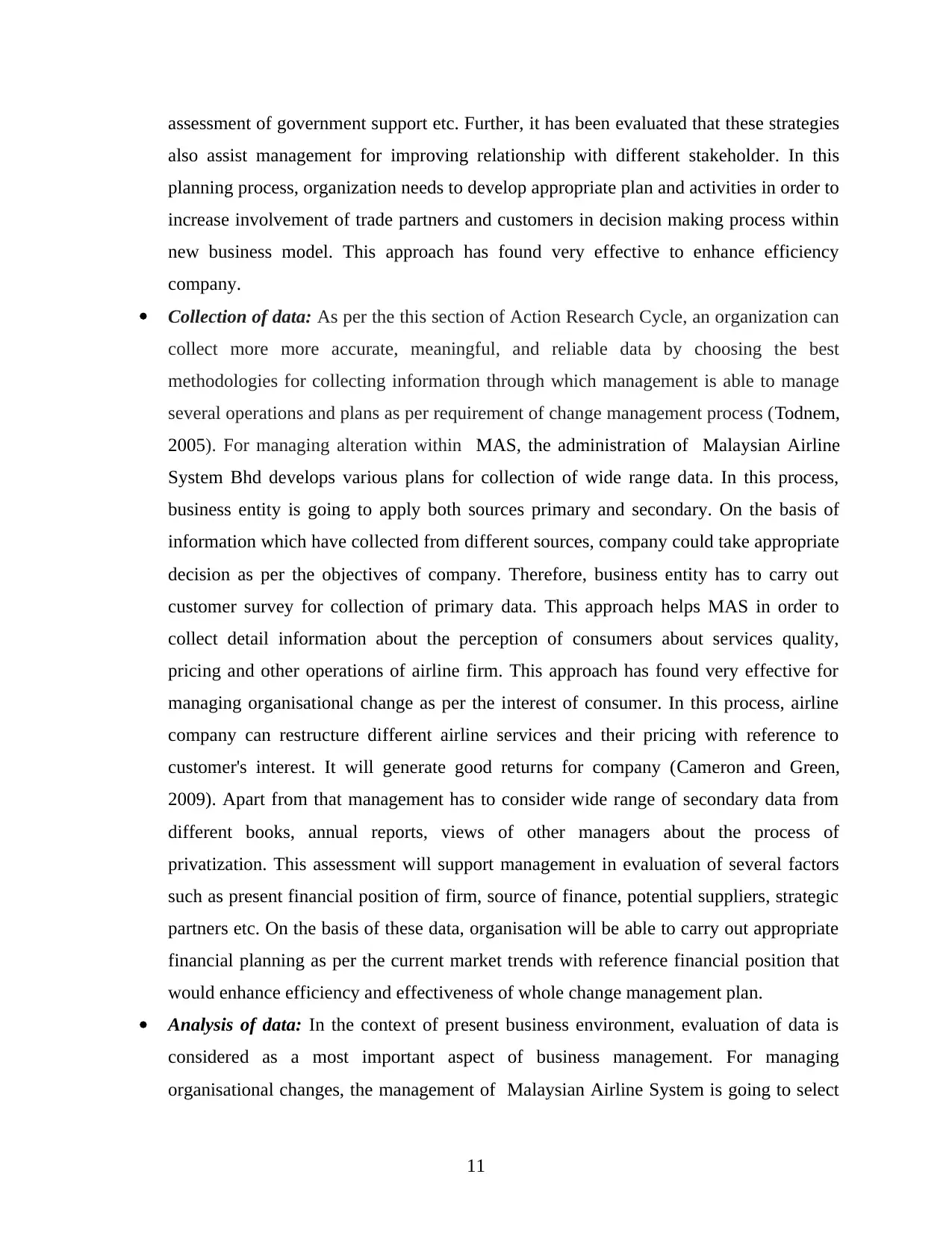
assessment of government support etc. Further, it has been evaluated that these strategies
also assist management for improving relationship with different stakeholder. In this
planning process, organization needs to develop appropriate plan and activities in order to
increase involvement of trade partners and customers in decision making process within
new business model. This approach has found very effective to enhance efficiency
company.
Collection of data: As per the this section of Action Research Cycle, an organization can
collect more more accurate, meaningful, and reliable data by choosing the best
methodologies for collecting information through which management is able to manage
several operations and plans as per requirement of change management process (Todnem,
2005). For managing alteration within MAS, the administration of Malaysian Airline
System Bhd develops various plans for collection of wide range data. In this process,
business entity is going to apply both sources primary and secondary. On the basis of
information which have collected from different sources, company could take appropriate
decision as per the objectives of company. Therefore, business entity has to carry out
customer survey for collection of primary data. This approach helps MAS in order to
collect detail information about the perception of consumers about services quality,
pricing and other operations of airline firm. This approach has found very effective for
managing organisational change as per the interest of consumer. In this process, airline
company can restructure different airline services and their pricing with reference to
customer's interest. It will generate good returns for company (Cameron and Green,
2009). Apart from that management has to consider wide range of secondary data from
different books, annual reports, views of other managers about the process of
privatization. This assessment will support management in evaluation of several factors
such as present financial position of firm, source of finance, potential suppliers, strategic
partners etc. On the basis of these data, organisation will be able to carry out appropriate
financial planning as per the current market trends with reference financial position that
would enhance efficiency and effectiveness of whole change management plan.
Analysis of data: In the context of present business environment, evaluation of data is
considered as a most important aspect of business management. For managing
organisational changes, the management of Malaysian Airline System is going to select
11
also assist management for improving relationship with different stakeholder. In this
planning process, organization needs to develop appropriate plan and activities in order to
increase involvement of trade partners and customers in decision making process within
new business model. This approach has found very effective to enhance efficiency
company.
Collection of data: As per the this section of Action Research Cycle, an organization can
collect more more accurate, meaningful, and reliable data by choosing the best
methodologies for collecting information through which management is able to manage
several operations and plans as per requirement of change management process (Todnem,
2005). For managing alteration within MAS, the administration of Malaysian Airline
System Bhd develops various plans for collection of wide range data. In this process,
business entity is going to apply both sources primary and secondary. On the basis of
information which have collected from different sources, company could take appropriate
decision as per the objectives of company. Therefore, business entity has to carry out
customer survey for collection of primary data. This approach helps MAS in order to
collect detail information about the perception of consumers about services quality,
pricing and other operations of airline firm. This approach has found very effective for
managing organisational change as per the interest of consumer. In this process, airline
company can restructure different airline services and their pricing with reference to
customer's interest. It will generate good returns for company (Cameron and Green,
2009). Apart from that management has to consider wide range of secondary data from
different books, annual reports, views of other managers about the process of
privatization. This assessment will support management in evaluation of several factors
such as present financial position of firm, source of finance, potential suppliers, strategic
partners etc. On the basis of these data, organisation will be able to carry out appropriate
financial planning as per the current market trends with reference financial position that
would enhance efficiency and effectiveness of whole change management plan.
Analysis of data: In the context of present business environment, evaluation of data is
considered as a most important aspect of business management. For managing
organisational changes, the management of Malaysian Airline System is going to select
11
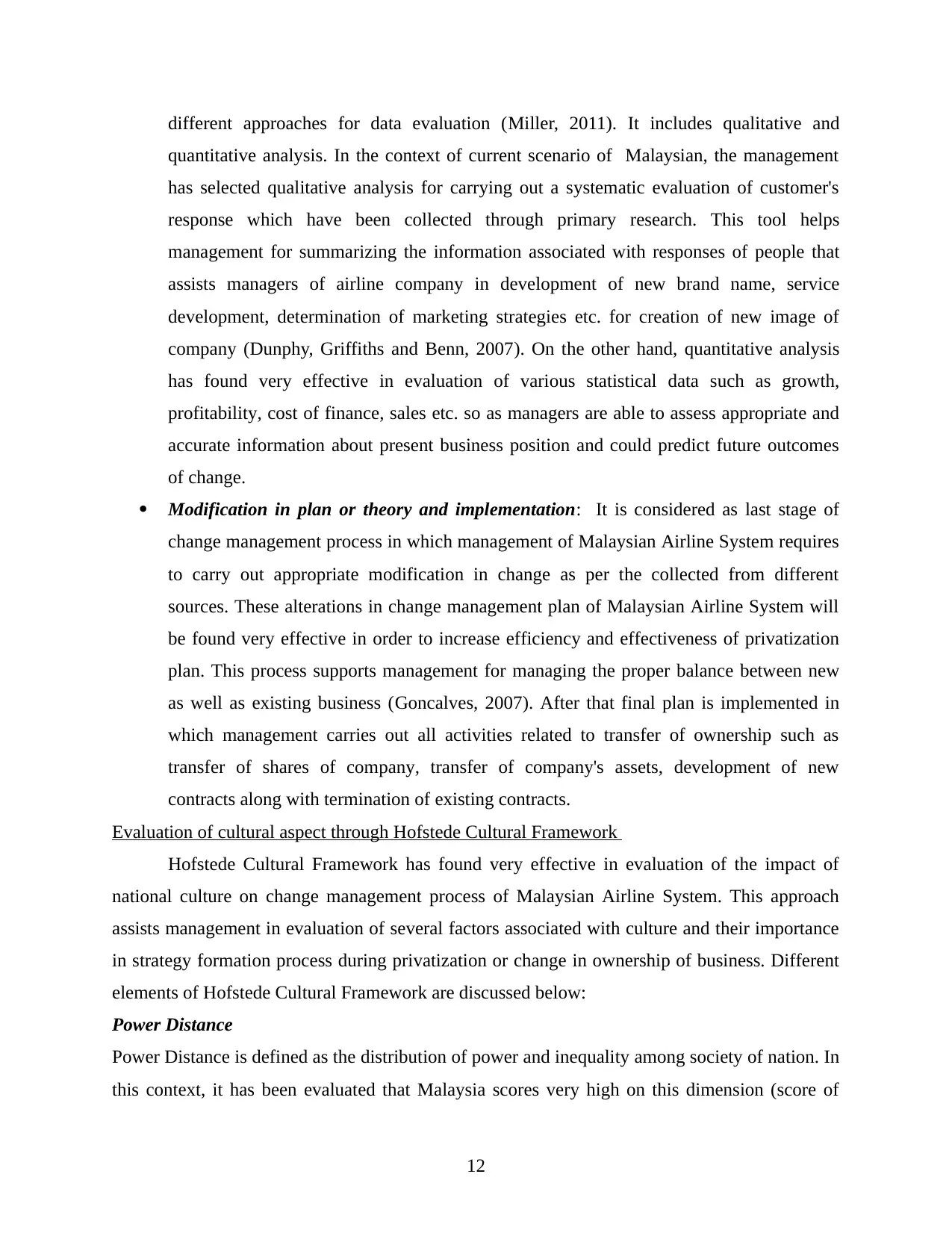
different approaches for data evaluation (Miller, 2011). It includes qualitative and
quantitative analysis. In the context of current scenario of Malaysian, the management
has selected qualitative analysis for carrying out a systematic evaluation of customer's
response which have been collected through primary research. This tool helps
management for summarizing the information associated with responses of people that
assists managers of airline company in development of new brand name, service
development, determination of marketing strategies etc. for creation of new image of
company (Dunphy, Griffiths and Benn, 2007). On the other hand, quantitative analysis
has found very effective in evaluation of various statistical data such as growth,
profitability, cost of finance, sales etc. so as managers are able to assess appropriate and
accurate information about present business position and could predict future outcomes
of change.
Modification in plan or theory and implementation: It is considered as last stage of
change management process in which management of Malaysian Airline System requires
to carry out appropriate modification in change as per the collected from different
sources. These alterations in change management plan of Malaysian Airline System will
be found very effective in order to increase efficiency and effectiveness of privatization
plan. This process supports management for managing the proper balance between new
as well as existing business (Goncalves, 2007). After that final plan is implemented in
which management carries out all activities related to transfer of ownership such as
transfer of shares of company, transfer of company's assets, development of new
contracts along with termination of existing contracts.
Evaluation of cultural aspect through Hofstede Cultural Framework
Hofstede Cultural Framework has found very effective in evaluation of the impact of
national culture on change management process of Malaysian Airline System. This approach
assists management in evaluation of several factors associated with culture and their importance
in strategy formation process during privatization or change in ownership of business. Different
elements of Hofstede Cultural Framework are discussed below:
Power Distance
Power Distance is defined as the distribution of power and inequality among society of nation. In
this context, it has been evaluated that Malaysia scores very high on this dimension (score of
12
quantitative analysis. In the context of current scenario of Malaysian, the management
has selected qualitative analysis for carrying out a systematic evaluation of customer's
response which have been collected through primary research. This tool helps
management for summarizing the information associated with responses of people that
assists managers of airline company in development of new brand name, service
development, determination of marketing strategies etc. for creation of new image of
company (Dunphy, Griffiths and Benn, 2007). On the other hand, quantitative analysis
has found very effective in evaluation of various statistical data such as growth,
profitability, cost of finance, sales etc. so as managers are able to assess appropriate and
accurate information about present business position and could predict future outcomes
of change.
Modification in plan or theory and implementation: It is considered as last stage of
change management process in which management of Malaysian Airline System requires
to carry out appropriate modification in change as per the collected from different
sources. These alterations in change management plan of Malaysian Airline System will
be found very effective in order to increase efficiency and effectiveness of privatization
plan. This process supports management for managing the proper balance between new
as well as existing business (Goncalves, 2007). After that final plan is implemented in
which management carries out all activities related to transfer of ownership such as
transfer of shares of company, transfer of company's assets, development of new
contracts along with termination of existing contracts.
Evaluation of cultural aspect through Hofstede Cultural Framework
Hofstede Cultural Framework has found very effective in evaluation of the impact of
national culture on change management process of Malaysian Airline System. This approach
assists management in evaluation of several factors associated with culture and their importance
in strategy formation process during privatization or change in ownership of business. Different
elements of Hofstede Cultural Framework are discussed below:
Power Distance
Power Distance is defined as the distribution of power and inequality among society of nation. In
this context, it has been evaluated that Malaysia scores very high on this dimension (score of
12
⊘ This is a preview!⊘
Do you want full access?
Subscribe today to unlock all pages.

Trusted by 1+ million students worldwide
1 out of 25
Related Documents
Your All-in-One AI-Powered Toolkit for Academic Success.
+13062052269
info@desklib.com
Available 24*7 on WhatsApp / Email
![[object Object]](/_next/static/media/star-bottom.7253800d.svg)
Unlock your academic potential
Copyright © 2020–2025 A2Z Services. All Rights Reserved. Developed and managed by ZUCOL.





